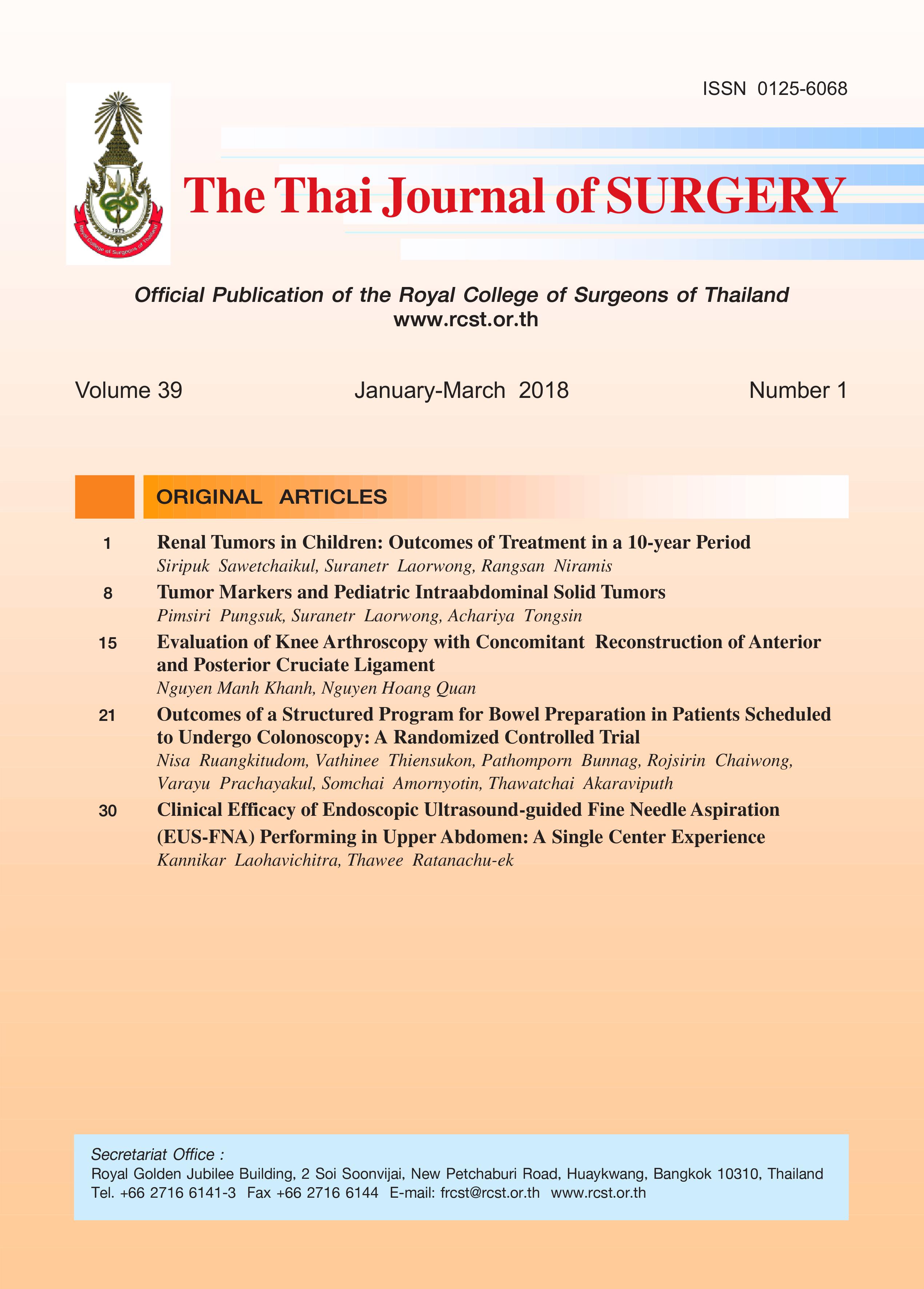Tumor Markers and Pediatric Intraabdominal Solid Tumors
Keywords:
Tumor markers, intraabdominal solid tumorsAbstract
Background: There are many tumor markers for initial investigation and diagnosis of pediatric intraabdominal solid tumors (ISTs). However, some types of ISTs cannot be diagnosed by tumor marker examinations because of no specific relationship between the tumor markers and these ISTs.
Purpose: The aim of this study was to analyse the relationships between tumor markers and pediatric ISTs.
Materials and Methods: A retrospective study of patients with ISTs who were initially treated at Queen Sirikit National Institute of Child Health form June 2015 to December 2016 was conducted. Patient data were collected from the medical records and were selected only among those with the definite diagnosis of ISTs. Tumor markers included neuron-specific enolase (NSE), 24-hour urine of vanillymandelic acid (VMA), serum ferritin, lactase dehydrogenase (LDH), serum alpha-fetoprotein (AFP), betahuman chorionic gonadotrophin (beta-hCG) and cancer antigen 125 (CA125). Information of the tumor markers and each type of ISTs were studied in order to demonstrate the relationships by using statistical analysis with SPSS program. The level of p-value less than 0.05 was considered significant.
Results: Thirty-six patients with ISTs were available for the study. The ISTs were finally definite diagnosis based on pathological reports including neuroblastoma, hepatoblastoma, hematologic tumors and retroperitoneal teratoma in 12 (33.3%), 6 (16.7%), 5 (13.9%) and 4 (11.1%), respectively. The 9 remaining ISTs were Wilms’ tumor (3), ovarian dysgerminoma (2) and others (4). NSE over 130 ng/ml and urine VMA over 2 mg/day were statistically significant for definite diagnosis of neuroblastoma (p = 0.033, 0.034). NSE level might elevate in ovarian dysgerminoma, Wilms’ tumor, lymphoma and leukemia but it was not statistically significant (p > 0.05). Increased NSE, 24-hour urine VMA and serum ferritin levels demonstrated a relationship to the severity of neuroblastoma both advanced stage and poor prognosis but no statistical significance. An elevation of LDH level might be found in many ISTs, but it revealed a significant relationship to ovarian dysgerminoma and N-myc amplification of neuroblastoma. High level of beta-hCG and CA 125 were observed in ovarian dysgerminoma. Marked elevation of average AFP level of 653,538 ng/ml was strongly indicated in diagnosis of hepatoblastoma (p = 0.01).
Conclusion: NSE over 130 ng/ml and urine VMA over 2 mg/day had a significant relationship to diagnosis of neuroblastoma. Marked elevation of LDH level was significantly demonstrated N-myc amplification of neuroblastoma and ovarian dysgerminoma. Marked elevation of AFP level was a strong indicator for diagnosis of hepatoblastoma in pediatric patient with ISTs.
References
2. Ehrlich PF, Shamberger RC. Wilms’ tumor. In: Coran AG, Adzick NS, Krummel TM, et al, editors. Pediatric surgery. 7th ed. Philadelphia: Elsevier; 2012. p. 423-40.
3. Meyers RL, Aronson DC, Zimmermann A. Malignant liver tumors. In : Coran AG, Adzick NS, Krummel TM, et al, editors. Pediatric surgery. 7th ed. Philadelphia : Elsevier; 2012. p. 463-90.
4. Bigbee W, Herberman E, Grubb R, et al. Tumor markers and immunodiagnosis. In : Bast RCJr, Kufe DW, Pollock RE, et al, eds. Cancer medicine. 6th ed. Hamilton, Ontario, Canada: BC Decker; 2003.
5. National Cancer Institute. Tumor markers. https://www.cancer.gov/about-cancer/diagnosis-staging/diagnosis/tumor-markers-fact-sheet. Reviewed : November 4,2015.
6. Tapia FJ, Polak JM, Barbosa AJA. Neuron-specific enolase is produced by neuroendocrine tumours. Lancet 1981; 1:808-11.
7. Carney DN, Marangos PJ, Ihde DC, et al. Serum neuronspecific enolase: a marker for disease extent and response to therapy of small-cell lung cancer, Lancet 1982; 1: 583-5.
8. Zeltzer PM, Marangos PJ, Parma AM. Raised neuron-specific enolase in serum of children with metastatic neuroblastoma. Lancet 1983;2:361-3.
9. Zeltzer PM, Marangos PJ, Evans AE. Serum neuron-specific enolase in children with neuroblastoma. Cancer 1986;57: 1230-2.
10. Odelstad L, Pahlman S, Lackgren G, et al. Neuron specific enolase: a marker for differential diagnosis of neuroblastoma and Wilms’ tumor. J Pediatr Surg 1982;17:381-5.
11. Tsuchida Y, Honna T, Iwanaka T, et al. Serial determination of serum neuron-specific enolase in patients with neuroblastoma and other pediatric tumors. J Pediatr Surg 1987;17:419-4.
12. Laug WE, Siegel SE, Shaw KNF, et al. Initial urinary catecholamine metabolite concentrations and prognosis in neuroblastoma. Pediatrics 1978;62:77-83.
13. Smith SJ, Diehl NN, Smith BD, et al. Urine catecholamine levels as diagnostic markers for neuroblastoma in a defined population: implications for ophthalmic practice. Eye (Lond) 2010;24:1792-6.
14. Sokoll LJ, Rai AJ, Chan DW. Tumor markers. In: Burtis CA, Ashwood ER, Bruns DE,eds. Tietz textbook of clinical chemistry and molecular diagnosis. Missouri: Elsevier; 2012: 627.
15. Allmen DV, Fallat ME. Ovarian tumors. In: Coran AG, Adzick NS, Krummel TM, et al, editors. Pediatric surgery. 7th ed. Philadelphia: Elsevier; 2012. p. 529-48.
16. Perkins GL, Slater ED, Sanders GK. Serum tumor markers. Am Fam Physic 2003;68:1075-82.
17. Silber JH, Evans AE, Fridman M. Models to predict outcome from childhood neuroblastoma: the role of serum ferritin and tumor histology. Cancer Res 1991;51:1426-33.
Downloads
Published
How to Cite
Issue
Section
License
Articles must be contributed solely to The Thai Journal of Surgery and when published become the property of the Royal College of Surgeons of Thailand. The Royal College of Surgeons of Thailand reserves copyright on all published materials and such materials may not be reproduced in any form without the written permission.



